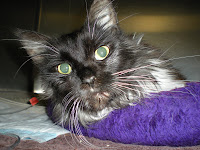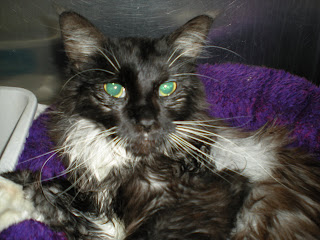
On a Friday night in January a two-year-old Maine coon cat named Spooky presented for unknown trauma. She was an indoor/outdoor kitty and her owner had found her crying with blood on her fur and not very responsive. Spooky was in shock when she arrived at Friendship, so we immediately placed an IV catheter and started fluids to help support her blood pressure.
Spooky's injuries were consistent with being hit by a car. She had blood on her face from a laceration and a fractured canine tooth. On physical exam we could feel her small intestines under her skin, which indicated an abdominal wall hernia. In addition, she was breathing too fast and had muffled heart sounds, which meant something was going on in her chest cavity. X-rays confirmed the abdominal hernia. They also showed us that she had bruising in her lungs and blood around her lungs, plus a suspected diaphragmatic hernia--a tear in the the diaphragm allowing abdominal organs to move into the chest cavity. As one can imagine, with the severe trauma to her lung tissue Spooky soon developed difficulty breathing and was placed in oxygen.
We were now in a difficult position. With the abdominal and suspected diaphragmatic hernias Spooky needed surgery before the blood supply was restricted in any of the misplaced organs. If we did not correct this as soon as possible the tissue could become damaged and possibly die. But given the condition her lungs were in she would probably not survive anesthesia. All we could do was support Spooky with fluids, antibiotics and pain management while we waited for her to become more stable. Injuries such as pulmonary contusions often worsen over the 48 hours following a traumatic event. We hoped that she would improve but if she continued to decline and there is very little we could do to help her.
Over the next 24 to 48 hours Spooky condition worsened. Her red blood cell count began to drop, indicating she was bleeding internally, most likely into her chest cavity. Giving her a transfusion of feline red blood cells would have been the best option, but her blood type did not match with the donor blood available. We were able to give her an artificial blood product called Oxyglobin to help support her, but this would only last for 24 to 48 hours.
Thankfully she responded well and was stable enough to go to surgery the Monday following the accident. At surgery we discovered that Spooky’s abdominal wall was torn and shredded but no harm was done to the small intestines. We also repaired a large tear in her diaphragm where a portion of her liver had been sitting in her chest cavity. She recovered quickly from surgery and started eating a few days later.
Spooky was sent home later that week on oral antibiotics and pain medications. However, once at home she started favoring her right front paw which she had not been doing while in the hospital. Her owner brought her back in for an x-ray which revealed a dislocation of her right wrist, which on a cat is located above her paw. She was seen by our orthopedic surgeon Dr. Walker, who placed a plate across her wrist to fuse the joint together. Spooky breezed through surgery again and was home in no time.
Her right front limb was placed in a splint to prevent movement while the wrist healed. The splint required weekly bandage changes. Unlike humans, our pets cannot tell us when something is wrong under the bandage so we must examine the area frequently. We check to see if the splint has been placed too tightly and is restricting blood flow or if it has rubbed on the skin and created a bandage sore. If any issues are discovered, we address them quickly, before they affect healing.
Two months after the event she is still enduring the weekly bandage changes but is always in good spirits. Spooky is an amazing cat. We were all inspired by her composure and bravery though the multiple hospital stays and surgeries. She would sit in her cage like a queen and was always happy for a head scratch and some attention. In the first few days, we were concerned that she wasn’t going to pull through, but she never stopped fighting and proved us wrong.
Spooky's injuries were consistent with being hit by a car. She had blood on her face from a laceration and a fractured canine tooth. On physical exam we could feel her small intestines under her skin, which indicated an abdominal wall hernia. In addition, she was breathing too fast and had muffled heart sounds, which meant something was going on in her chest cavity. X-rays confirmed the abdominal hernia. They also showed us that she had bruising in her lungs and blood around her lungs, plus a suspected diaphragmatic hernia--a tear in the the diaphragm allowing abdominal organs to move into the chest cavity. As one can imagine, with the severe trauma to her lung tissue Spooky soon developed difficulty breathing and was placed in oxygen.
We were now in a difficult position. With the abdominal and suspected diaphragmatic hernias Spooky needed surgery before the blood supply was restricted in any of the misplaced organs. If we did not correct this as soon as possible the tissue could become damaged and possibly die. But given the condition her lungs were in she would probably not survive anesthesia. All we could do was support Spooky with fluids, antibiotics and pain management while we waited for her to become more stable. Injuries such as pulmonary contusions often worsen over the 48 hours following a traumatic event. We hoped that she would improve but if she continued to decline and there is very little we could do to help her.
Over the next 24 to 48 hours Spooky condition worsened. Her red blood cell count began to drop, indicating she was bleeding internally, most likely into her chest cavity. Giving her a transfusion of feline red blood cells would have been the best option, but her blood type did not match with the donor blood available. We were able to give her an artificial blood product called Oxyglobin to help support her, but this would only last for 24 to 48 hours.
Thankfully she responded well and was stable enough to go to surgery the Monday following the accident. At surgery we discovered that Spooky’s abdominal wall was torn and shredded but no harm was done to the small intestines. We also repaired a large tear in her diaphragm where a portion of her liver had been sitting in her chest cavity. She recovered quickly from surgery and started eating a few days later.
Spooky was sent home later that week on oral antibiotics and pain medications. However, once at home she started favoring her right front paw which she had not been doing while in the hospital. Her owner brought her back in for an x-ray which revealed a dislocation of her right wrist, which on a cat is located above her paw. She was seen by our orthopedic surgeon Dr. Walker, who placed a plate across her wrist to fuse the joint together. Spooky breezed through surgery again and was home in no time.
Her right front limb was placed in a splint to prevent movement while the wrist healed. The splint required weekly bandage changes. Unlike humans, our pets cannot tell us when something is wrong under the bandage so we must examine the area frequently. We check to see if the splint has been placed too tightly and is restricting blood flow or if it has rubbed on the skin and created a bandage sore. If any issues are discovered, we address them quickly, before they affect healing.
Two months after the event she is still enduring the weekly bandage changes but is always in good spirits. Spooky is an amazing cat. We were all inspired by her composure and bravery though the multiple hospital stays and surgeries. She would sit in her cage like a queen and was always happy for a head scratch and some attention. In the first few days, we were concerned that she wasn’t going to pull through, but she never stopped fighting and proved us wrong.









No comments:
Post a Comment